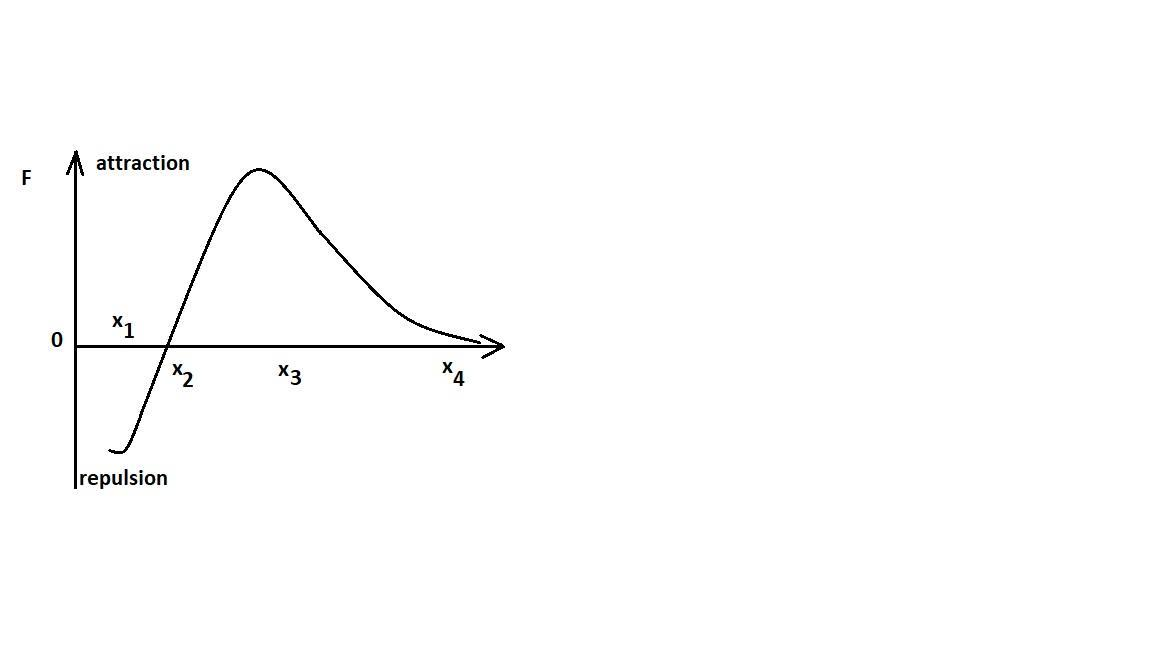
The diagram given shows how the net interaction force (conservative) between two particles $A$ and $B$ is related to the distance between them varies from \[{x_1}\] to \[{x_2}\] . Then
(A) Potential energy of the system increases from \[{x_1}\] to \[{x_2}\]
(B) Potential energy of the system increases from \[{x_2}\] to \[{x_3}\]
(C) Potential energy of the system increases from \[{x_3}\] to \[{x_4}\]
(D) KE increases from \[{x_1}\] to \[{x_2}\] and decreases from \[{x_2}\] to \[{x_3}\]

Answer
222.6k+ views
Hint: We will pull in the concept of potential energy to be the work done stored by the system. We will then try out the relationships and then finally find the correct option.
Formulae Used $F = - \frac{{dU}}{{dx}}$
Step By Step Solution
Firstly,
$F = - \frac{{dU}}{{dx}}$
Thus, we can say,
\[dU = - Fdx\]
Now,
Clearly,
When $F$ is positive, $dU$ is negative and when $F$ is negative, $dU$ is positive.
For the region from \[{x_1}\] to \[{x_2}\] , $F$ is negative as we can see from the graph itself.
Thus, $dU$ is positive.
Which means potential energy increases from \[{x_1}\] to \[{x_2}\].
Now,
Again for the region \[{x_2}\] to \[{x_3}\], $F$ is positive.
Thus, we can say $dU$ is negative.
Which means that potential energy decreases from \[{x_2}\] to \[{x_3}\].
Now,
For the region \[{x_3}\] to \[{x_4}\] , the force keeps on decreasing making it negative.
Thus,
$F$ is negative here.
Thus,
\[dU\] is positive.
Which means potential energy increases here.
Thus, taking all these observations into consideration, we can say (A) is the correct option.
Note: When $dU$ is positive, the potential energy increases because $dU$ refers to the change in the potential energy. When its value is positive, the final potential energy value is greater than the initial potential energy value. Thus making its overall value to be positive. The same analogy goes true when $dU$ is negative.
Formulae Used $F = - \frac{{dU}}{{dx}}$
Step By Step Solution
Firstly,
$F = - \frac{{dU}}{{dx}}$
Thus, we can say,
\[dU = - Fdx\]
Now,
Clearly,
When $F$ is positive, $dU$ is negative and when $F$ is negative, $dU$ is positive.
For the region from \[{x_1}\] to \[{x_2}\] , $F$ is negative as we can see from the graph itself.
Thus, $dU$ is positive.
Which means potential energy increases from \[{x_1}\] to \[{x_2}\].
Now,
Again for the region \[{x_2}\] to \[{x_3}\], $F$ is positive.
Thus, we can say $dU$ is negative.
Which means that potential energy decreases from \[{x_2}\] to \[{x_3}\].
Now,
For the region \[{x_3}\] to \[{x_4}\] , the force keeps on decreasing making it negative.
Thus,
$F$ is negative here.
Thus,
\[dU\] is positive.
Which means potential energy increases here.
Thus, taking all these observations into consideration, we can say (A) is the correct option.
Note: When $dU$ is positive, the potential energy increases because $dU$ refers to the change in the potential energy. When its value is positive, the final potential energy value is greater than the initial potential energy value. Thus making its overall value to be positive. The same analogy goes true when $dU$ is negative.
Recently Updated Pages
JEE General Topics in Chemistry Important Concepts and Tips

JEE Extractive Metallurgy Important Concepts and Tips for Exam Preparation

JEE Atomic Structure and Chemical Bonding important Concepts and Tips

JEE Amino Acids and Peptides Important Concepts and Tips for Exam Preparation

Electricity and Magnetism Explained: Key Concepts & Applications

JEE Energetics Important Concepts and Tips for Exam Preparation

Trending doubts
JEE Main 2026: Application Form Open, Exam Dates, Syllabus, Eligibility & Question Papers

Derivation of Equation of Trajectory Explained for Students

Hybridisation in Chemistry – Concept, Types & Applications

Understanding the Angle of Deviation in a Prism

How to Convert a Galvanometer into an Ammeter or Voltmeter

Degree of Dissociation: Meaning, Formula, Calculation & Uses

Other Pages
JEE Advanced Marks vs Ranks 2025: Understanding Category-wise Qualifying Marks and Previous Year Cut-offs

Thermodynamics Class 11 Physics Chapter 11 CBSE Notes - 2025-26

Units And Measurements Class 11 Physics Chapter 1 CBSE Notes - 2025-26

NCERT Solutions For Class 11 Physics Chapter 8 Mechanical Properties Of Solids

Motion in a Straight Line Class 11 Physics Chapter 2 CBSE Notes - 2025-26

Laws of Motion Class 11 Physics Chapter 4 CBSE Notes - 2025-26




